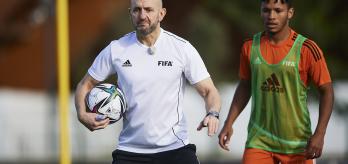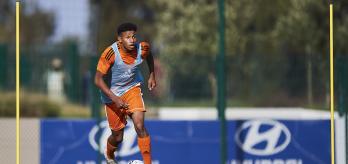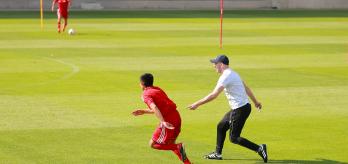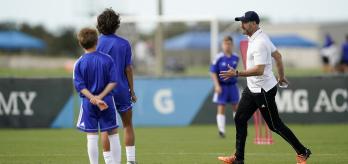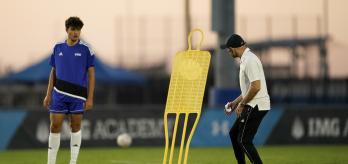As a training method, it revolves around individual players and the collective coordination of physical and technical speed between units of players to form a single, dynamic and efficient methodology for training and development of functional football speed.
The physical component
Speed training within football has traditionally been divided into two main areas: the physical component and the technical component.
The physical aspect of speed training typically comes within the remit of a team's sports science and strength and conditioning department, which aims to provide appropriate training programmes for all physical elements within speed training, including power, acceleration, agility, maximal velocity and speed endurance.
Another set of associated objectives concerns speed metrics, which relate to workload, i.e. the number and distance of accelerations and sprints and amount of high-speed running (HSR) performed within a given time frame. Speed metrics objectives for individual players or a squad can be quantified in terms of weekly targets, which are typically calculated to mirror the average weekly speed intensity demands involved in training and match play. This is an essential training objective, especially for players who have little exposure to match speed due to their limited actual game time.
In the case of some players, the demands involved in match play fulfil all of their speed requirements for the training week. Players who consistently play two matches per week hardly require any additional speed work. However, it is important that all squad members and up-and-coming young players develop or maintain their speed metrics intensity needs and status, which is where training comes into play.
Many of the training programmes deployed to develop the physical component of speed, including those which aim to fulfil the speed metrics objectives, involve standardised, non-specific formal athletic development methodologies, which can be adapted to meet the training objectives for a number of running sports, including football.
In this instance, the training exercises consist of explosive movements, jumping, sprinting and HSR, all of which involve various sets, repetitions and distances. These non-football-specific exercises are typically limited in terms of their use of the ball and exposure to the unique complexity of high-tempo technical movements.
That said, these exercises sometimes feature a nod to the functionality of football; for example, an attacking player may perform a jump and sprint, before dribbling the ball around a couple of poles and rounding the drill off with a shot on goal. Likewise, defenders may make headed clearances, before sprinting to retrieve the ball. The common denominator in such cases is that the ball acts as a prop that is used to create an illusion of football specificity. However, these exercises rarely bear any real resemblance to the unique functional coordination required in high-tempo match play and they can therefore be considered one-dimensional.
By contrast, functional football speed is very much a multidimensional art. It can be defined as a blend of technique, physicality and collective cohesion between players. A typical counter-attacking passing sequence between a trio of players (as seen in the video above) represents a common example that clearly evidences combined physical and technical qualities. The quality on show in such sequences may create an assumption of simplicity, an illusion behind which lie a host of football skills that have been developed by repeatedly performing multidimensional speed coordination tasks.
The technical component
The technical component involved in speed training comes within the remit of a team's football coaching department. Technical sessions that take place in a sizeable training area and involve exercises performed at a high tempo can result in the attainment of technical speed outcomes. Drills comprising 1v1, 2v2, 3v3, etc. and other small-sided games, in which there are few participating players relative to the size of the playing area, naturally tend to generate a high tempo. Other technical speed formats include a variety of attacking combination moves performed at speed that involve finishing, which offer players exposure to sprint and HSR zones in a training scenario. Attacking exercises that feature a high press expose players to considerable acceleration and deceleration workloads. In addition, practice matches that involve a small number of players relative to the pitch size can represent a useful exercise. As noted above, this stretching of the pitch automatically serves to increase the tempo.
All of the aforementioned exercises have a positive influence on the natural development of an individual player's technical speed, the coordination of speed between players and, to some degree, physical speed. However, fulfilling the speed metrics requirements (velocity and work volume) can prove to be a challenge in such training sessions, in which speed constitutes just one of many incidental training outcomes and is not necessarily the main objective within the session. As a result, there can be large disparities between speed metrics targets and outcomes in training. This is generally the case when a session is full of multifocal technical exercises that are repeatedly stopped and restarted for coaching interventions.
Another consideration to bear in mind within an exercise relates to its tempo, which may be slightly too relaxed and therefore fall short of the required speed thresholds. Players infrequently achieve maximal speed in technical training and some players tend to train within themselves. In addition, the recovery time between actions may be too long, while inferior technical ability can also hinder tempo levels, and players do not always receive equal exposure to the speed demands within an exercise or the overall session. All of these variables can ultimately compromise speed intensity levels.
To combat disparities in speed training, the modern game has evolved and incorporated GPS technology to track player training metrics in real time. When players fail to achieve speed metrics targets during high-tempo technical exercises, a member of the conditioning department will sometimes intervene at the end of the session and ask the players in question to perform a number of formal, HSR drills or sprints until the loading targets have been met. However, this approach somewhat dilutes the functionality element of training and may be a time where more functional element methods are applied.
Speed technical coordination perspective
Players should be encouraged to achieve the vast majority of their weekly speed intensity targets through purposeful football movements performed in coordination with the ball. One approach involves devoting time to the implementation of focused speed training exercises, where the goal is to combine physical aspects, including speed metrics requirements, with technical components of the game. This can provide a training platform to satisfy all speed training needs for both individual players and a team. This approach removes the need for (non-football-specific) formal high-speed running exercises and means that, where necessary, a small number of maximal sprints is all that is required to help players to maintain their trained status at 95% or more of maximal speed.
Speed technical coordination training objectives
The objective is to provide a combined technical and physical training methodology that involves the following key football-specific training elements:
- Speed acceleration, HSR and speed zone tempo at near-maximal speed thresholds
- Speed metrics: work rate, repetitions and distance per unit of time
- High-tempo technique and technical movement
- High-tempo technical coordination between a unit of players (cohesion)
- Passing quality at a high tempo
- Reinforcement and development of good footballing habits at a high tempo (specifically scanning)
The overall goal is to provide an efficient training methodology to develop functional football speed.
Speed technical coordination exercises
The drills are based on an extensive range of high-tempo football scenarios that primarily involve attacking patterns of the game that are structured and adapted into simulations of high-tempo passing and movement combinations between units of players, which include the nuances of player interactions at speed.
The following represent examples of such scenarios:
- Timing a run in behind in coordination with a team-mate's movement to enable the player to execute a pass
- Making a curved run to meet a vertical pass
- Turning inside and accelerating away, before playing a diagonal pass between the lines
These represent just a few examples of the many functional scenarios within the exercises that feature in the speed technical coordination circuits. These drills enable players to fulfil the vast majority of their speed training needs in a functional training environment, instead of performing straight-line accelerations and HSR drills along the side of the pitch in order to meet the speed metrics requirements.
Speed metrics
The globally recognised HSR threshold is 5.5-7m/sec. and the sprint zone (SZ) threshold is above 7m/sec. If we were to take the hypothetical example of a weekly SZ minimum target of 400m and we need to cover approximately 200m in an individual session to bring the players up to their minimum treshold, this can be achieved by carrying out a simple calcuation of distance multiplied by the number of repetitions.
For example, eight 30m runs, with approximately 25m of each run completed in the SZ. If there were further requirements to reach near-maximal speed (95% or more of their top speed), a couple of maximal efforts would be required within the eight repetitions.
Functional speed metrics are all about achieving the targeted HSR and SZ workloads within football-based training and not through non-specific, straight-line running, but rather through high-tempo individual and collective football coordination exercises. Speed technical coordination circuits can achieve the same metrics requirements, and if there is a need to achieve 95% or more of maximal speed, the same formal top-up protocols apply.
The circuit exercises are designed for players to be in the high speed zones for a period of time within each repetition, while offering the added benefit of honing players' technical qualities. Rarely do sprints within the speed technical coordination circuits involve only straight-line running, with the majority requiring physical speed applied in a functional environment within the football context.
Speed technical coordination training structure
Speed technical coordination exercises are performed in grids in which the set-up involves mannequins or poles, flat discs and goals (if the drill includes a finishing element). This equipment marks the reference points for accelerations and HSR, plus the technical interaction, movement coordination and passing sequences between players.
The circuits comprise two categories: speed with finishing and speed without finishing.
The speed-with-finishing circuits involve a more functional end to each sequence. They place slightly greater emphasis on the technical component of speed and the enjoyment factor in such drills is higher. However, the overall speed intensity is lower compared to a continuous circuit rotation that does not include finishing. In addition, lapses are a more frequent occurrence when finishing is included due to the higher level of technical and physical cohesion required between players.
The drills are performed in grids of three sizes: small, medium and large. The grids for exercises that do not involve finishing measure 40m, 50m or 60m in length, while the grids for drills that include a finishing element measure 60m, 70m or 80m in length, which reflects the additional space required when shooting on goal. The grid dimensions are aligned with the training objectives: smaller grid circuits target speed accelerations of 15-20m, while larger grids involve 40m of HSR that is closer to maximal speed intensity. The training objectives are also reflected by the passing distances: shorter (15-25m) passing distances are involved in the acceleration circuits, while the HSR circuits involve passes of up to 40m.
Features of applied training methodology:
- Groups of a minimum of 5 players with 1 ball in rotation or up to 16 players with 2 balls
- Multiple high-tempo movement patterns within technically coordinated football
- Exercise distances to ensure attainment of acceleration, HSR and SZ objectives
- Passing distances of up to 40m to provide a training stimulus to promote the development of high-quality long-distance passing
- Player numbers and exercise duration established to meet speed metrics objectives
- High repetition of exercises with continuous ball rotation to achieve speed metrics objectives
- Cohesion between physical and technical components of speed among individual players and collectively
- Training efficiency, with high technical and physical speed per unit of time
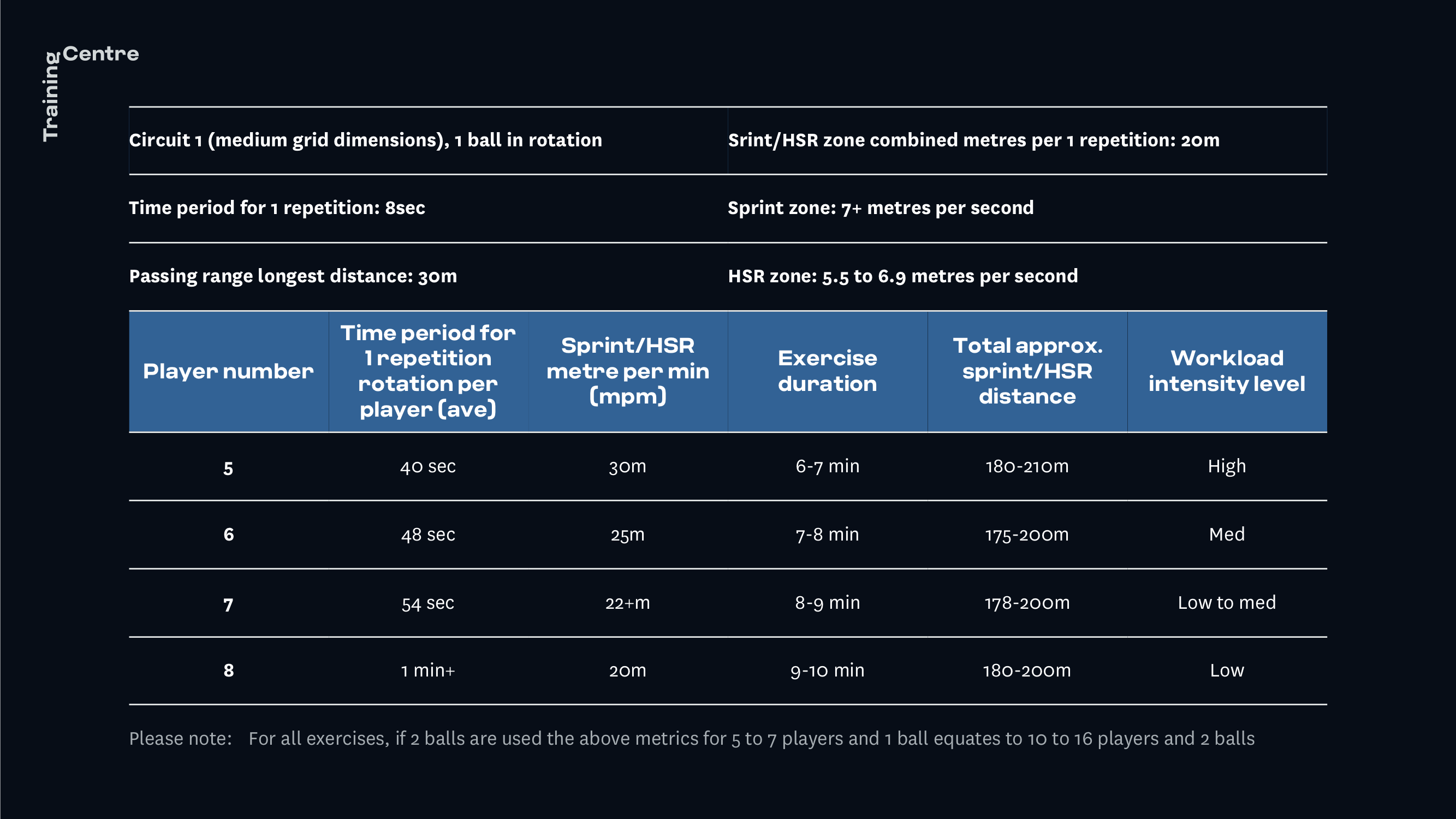
Summary
Speed technical coordination is a training concept that addresses the main functionalities of football speed training, physical speed and workload metrics that come together in an environment of high-tempo technique and technical movement to form a focused training and development methodology for functional football speed.







